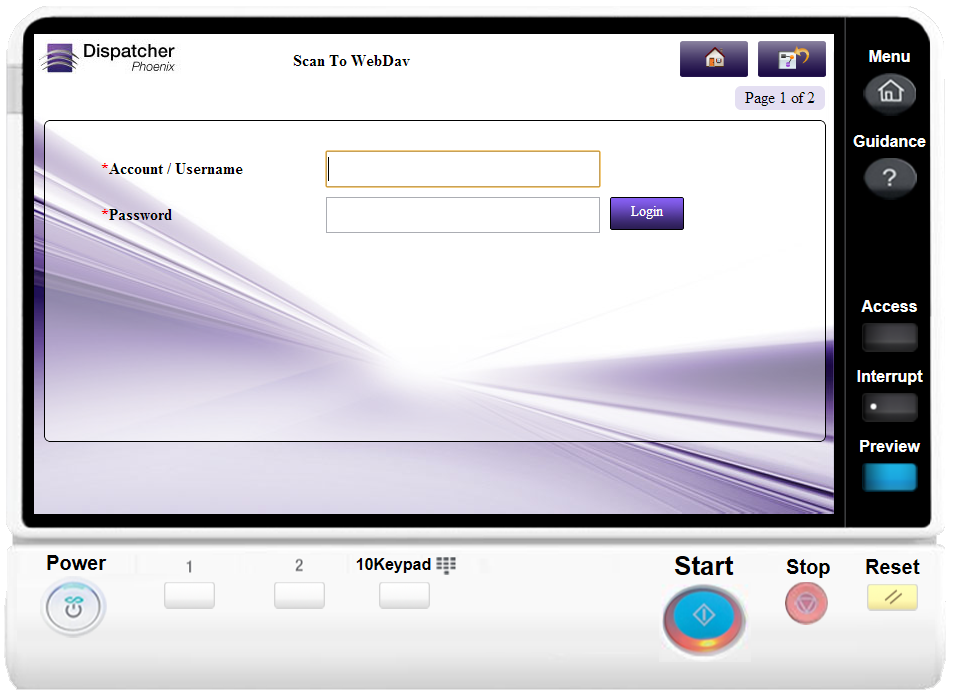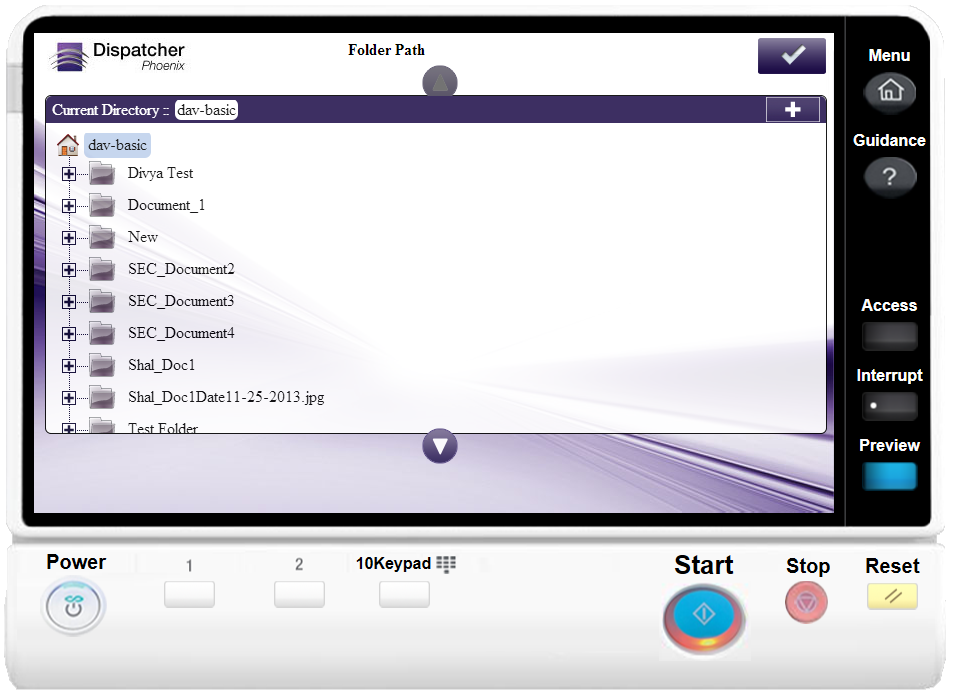WebDAV Connector

WebDAV (Web-based Distributed Authoring and Versioning) is a standard protocol allowing users to access files on remote web servers. The Dispatcher Phoenix WebDAV Connector allows you to browse folders and upload files on a WebDAV Server. Documents can be sent to a WebDAV Server via an automated workflow, or you can log into the WebDAV Server directly at the MFP panel.
Note: To use the WebDAV Connector, you must have access to a WebDAV Server.
To open the WebDAV Connector node’s properties window, add an output node for WebDAV to your workflow and double-click on it.

-
Check the Enabled box when there are multiple output locations. When unchecked, this output will be ignored. While the workflow will still validate, documents will not be output and may be lost.
-
In the Node Name field, enter a meaningful name for the WebDAV Connector node.
-
In the Description field, enter a description for the WebDAV Connector node. Although this is not required, it can be helpful to distinguish multiple destination nodes from each other. If the description is long, you can hover the mouse over the field to read its entire contents.
Configuring the WebDAV Connector
To configure the WebDAV Connector, you must first connect to your WebDAV Server; then you can specify an existing WebDAV folder or create a new folder to send files to.
Connecting To WebDAV
To begin, you must first connect to the WebDAV Server. In the WebDav Authorization area, do the following:
-
In the WebDAV URL field, enter the URL address of your WebDAV Server.
-
Enter your WebDAV Server user credentials in the Account / User Name and Password fields.
-
Change the seconds allotted for the time without communication (after the initial connection to the server) before a timeout occurs using the Connection Timeout field, if necessary. The default timeout value is 30 seconds.
-
When you are done, select the Login button to connect to your WebDAV Server.
Selecting A Folder
Once connected, the right hand side of the WebDAV node properties window displays a tree-view of your WebDAV folders and documents that allows you to browse through your WebDAV folders and select a folder for your documents.
Sending Documents To A New Folder
You can also choose to create a new folder in WebDAV to send documents to. Do one of the following:
-
Select the New folder option from the Options drop-down menu.
In the Create New Folder window that appears, enter the name for the new folder in the Name field; then select the Create button. The newly created folder will now appear in the Folder view. In the following illustration, a new folder called “New Folder” is being created as a subfolder within the Financial Documents folder.

-
Enter a new folder name in the Folder Path field.
-
Use metadata to specify a folder path at run time.
For example, you could use zonal OCR to extract client names from incoming documents and then use that OCR metadata in the Folder Path field. In this case, a folder name with the client name will be created on the WebDAV Server and documents will be automatically uploaded to that new folder at run time.
Note: You cannot create a folder within a folder that does not already exist. For example, you cannot use two different metadata variables to create a folder within a folder (e.g., {bates:Counter}/{file:name}).
To use metadata, do the following:
-
Select the Metadata button to open up the Metadata Browser window.
-
On the Metadata Browser window, select the metadata variable you are interested in; then drag-drop it to the Folder Path field.
-
Select the Close button on the Metadata Browser window.
-
File Name Restrictions
The following restrictions apply to file names:
-
File names cannot start with a space or end with a space.
-
You cannot start a file name with two period characters (..).
-
Non-printable characters cannot be included in a file name (tabs, newlines, etc.)
-
Do not use < > : " / \ | ? *
View Options
You can adjust the default view of your WebDAV folders in the node properties window by doing the using the Options button on the top right hand side of the window. Do the following:
-
Click on the Options button. The following drop-down menu will appear:

-
To turn off the default view, uncheck the Show tree view option.
See the following illustrations for comparison on the different folder views available:
Tree View ON

Tree View OFF
 |
| -
To hide the files stored in WebDAV folders, uncheck the Show files option.
-
To refresh the current view with the most up-to-date folders/files, select the Refresh option.
Using with Index Form
When using the WebDAV Connector node on an Index Form, the WebDAV Connector node properties window will be automatically populated with the variable names of the fields on the Index Form. Although you cannot edit the fields on this window, you can click on the wrench tool button to go to that section or field in the Index Form Builder. See the following illustration:

Using WebDAV Connector Index Form With Multiple Inputs
Once you associate your WebDAV Connector node with a MFP Panel node’s index form, all the information necessary to connect and route to WebDAV is entered at the MFP. Because of this, you cannot connect any other types of collection nodes (Input Folder, MFP User Box, etc.) to that indexed WebDAV Connector node in your workflow. In this case, if you need to add other collection nodes to your workflow, you must add a new WebDAV node that is not connected to an index form.
Creating A WebDAV Server Index Form
You can create an index form that allows you to upload scanned documents to a generic WebDAV server at the MFP. Do the following:
-
Make sure that your workflow includes a MFP Panel node and WebDAV Connector node.
-
Configure the WebDAV Connector node to connect to the appropriate WebDAV server and folders.
-
Open up the Index Form Builder from the MFP Panel node. You should see a WebDAV Connector button under the Workflow Index Fields area.
-
Drag and drop the WebDAV Connector button to the Index Form work area. A Scan to WebDav index form will automatically appear, as in the following illustration:

-
Save and close the Index Form Builder.
Note: As an alternative, you can create a WebDAV Index Form without customizing the WebDAV Connector first. In this case, do the following:
-
Create a workflow with a MFP Panel node and WebDAV Connector node.
-
Customize the MFP Panel node with a blank Index Form.
-
Drag-drop the WebDAV Connector button to the Index Form Builder’s work area.
-
Configure the Default value field for the RootURL hidden field with the WebDAV Server’s URL. Note that you must include “http://” or https:// as part of the URL address.
-
Configure the WebDAV Data Source Configuration window’s Folder Path field with the complete path of the WebDAV Server’s folder.
-
Save the Index Form Builder.
-
WebDAV Index Form On MFP
At the MFP, the WebDAV Index Form will be separated into three separate screens, as follows:


A Search field is provided for you to use to narrow the list of folders. This field features type-ahead functionality to help you quickly filter the folders displayed on the screen. You can begin entering characters into the field and the folders will be filtered accordingly (searching only the first level of sub-folders from the current path).
-
A wildcard asterisk (*) can be used to represent more characters in a string of characters. For example, if entering inv* in the Search field, the folder results would display any folders that begin with those three letters (e.g., inv01, inv02, invoice, etc.). Or, if entering *inv in the Search field, the folder results would display any folders that end with those three letters (e.g., 01inv, 02inv, etc.)
-
A wildcard question mark (?) can be used to represent an arbitrary character. For example, if entering INV0? in the Search field, the folder results would display INV01, INV02, INV03, etc.

Once the folder list is filtered per your search, you can do the following:
- Tap on the Use button to select that particular folder.
- Tap on the View button to return to a directory structure view of that particular folder.
- Release the filter by tapping on the X button next to the Search field.
- Tap on the Search icon next to the field to submit the search criteria again.
Database Browsing - WebDAV Configuration
You can also manually configure a query to retrieve data (e.g., list of folders, validation, etc.) from a WebDAV Server.
Using the Index Form Builder, do the following:
-
Add a new field, such as a drop-down list.
-
Define an On Load event for the field; then add a Query.
-
Choose WebDAV Data Source from the Query drop-down list.
-
The WebDAV Data Source Configuration window appears, which allows you to perform specific actions in order to retrieve data from the WebDAV Server.

Do the following:
-
In the Friendly Name field, enter an identifying name for the WebDAV data source configuration.
-
In the WebDAV Authorization area, provide the information necessary to connect to the WebDAV Server.
-
Select the Test Connection button to make sure that you are connected properly to the WebDAV Server.
-
In the Action area, choose what kind of action to perform on the WebDAV data source. Options include:
-
Validate WebDAV Login - Use this action to validate the login credentials that are entered at the MFP (user name and password) against the WebDAV data source. This action returns the following records:
-
[result] - The result of the login: true or false
-
[message] - Text regarding a successful or unsuccessful login.
-
-
Get WebDAV Folders - Use this action to display a list of folders with a given WebDAV Server root path. When you select the Get WebDAV Folders item, you can configure the following fields:

-
Enter the WebDAV Server’s root path in the Folder Path field
-
Check the Show new folder option if you want to be able to create a new folder to scan your documents to at the MFP panel.
-
Check the Show files option to view a list of files that are included in each subfolder at the MFP panel.
-
Enable folder search – Check this option to display a Search field that can be used to filter the list of WebDAV folders displayed on the panel. Note that the Search field includes type ahead functionality. This option is enabled by default.
-
-

